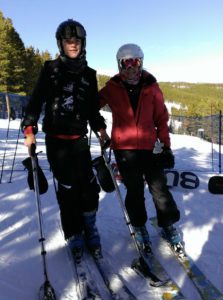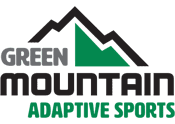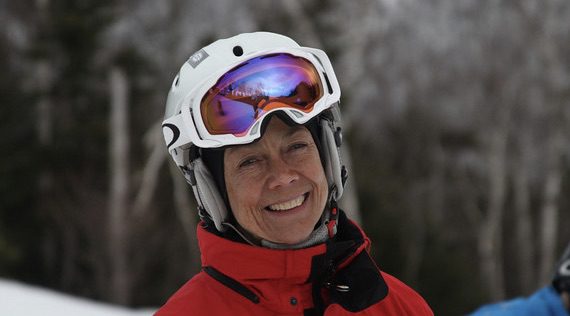Cynthia Needham has been president of Green Mountain Adaptive Sports since it was founded in 2009. We reached out to her to get to know her better, and understand how GMAS works, as well as discuss some of the challenges and opportunities that the program faces.
GMAS: Can you tell us about yourself?
Cynthia: I’m a medical microbiologist by training and spent over 30 years in the Boston health care community, directing the Microbiology Diagnostic Services at Boston University Medical Center and then at Lahey Medical Center while serving on the BUSM faculty. I moved to Vermont when I founded ICAN Productions because I loved the area and loved the skiing. In 1999, the winter after I arrived in Stowe, I was encouraged to join the Stowe Mountain Resort Ski and Ride School. It’s there that I was introduced to adaptive coaching, and I was immediately hooked. After several years I became head of the adaptive program and was able to see it grow and become an important part of the Ski and Ride School’s offerings.
I’ve had a variety of experiences that have helped me in leading GMAS. I served as a member of the Board and then as the National Secretary for my professional organization (the American Society for Microbiology), as well as President of the Board of the Clarina Howard Nichols Center, and have chaired a variety of committees along the way. I founded Friends of Stowe Adaptive Sports (now Green Mountain Adaptive Sports) with Ken McPherson in 2009 and have served as Board President since that time.
It’s been a privilege to work with so many athletes with disabilities and to share in their excitement in discovering their strengths and talents. My life has been enriched by being able to facilitate and witness so many life-changing experiences for people and families who believed that they would never be able to participate in sports and recreation.
GMAS: Can you tell us a little about how GMAS got started?
Cynthia: GMAS began life because of a party. The SMR adaptive program had very little specialized equipment, which limited the type of lessons we could provide. Hence, the first Ski Bum Prom was organized to raise money for a new sit-ski. This highly successful event raised more than enough money for the ski and brought together members of the skiing community to rally around a good cause. It was also apparent that cost was a significant barrier to participation in skiing for individuals with disabilities living in our region. With the fundraising success, we recognized that we could address this inequity. However, we needed a non-profit vehicle to go forward, and the first iteration of GMAS (Ability Plus) came into being. In 2011, we separated from Ability Plus and founded Friends of Stowe Adaptive Sports as a chapter of Disabled Sports USA. Over the years, the mission, and offerings of GMAS have broadened and the name of the organization was officially changed to Green Mountain Adaptive Sports to reflect those changes in 2019.
GMAS: Can you talk about the model that GMAS follows, and how it is different from other adaptive programs?
Cynthia: Our vision is that no athlete gets left on the sidelines.
 To that end, GMAS operates like a small foundation. There is no paid staff at GMAS. All our work is carried out by a small group of volunteers, most of whom are board members. This allows us to apply approximately 90% of the funds we raise to our programming. We raise money to support athletes, train coaches, and purchase equipment essential to the functioning of an adaptive recreational or sports program. Importantly, we also partner with regional recreational and sports organizations to foster their ability to offer adaptive experiences. We currently partner with Stowe Mountain Resort, The Swimming Hole, and Elevate in Stowe, Craftsbury Outdoor Center, MetroRocks in Burlington, and the Northeast Disabled Athlete Association. The programming includes skiing, riding, swimming, agility training, rock climbing, and kayaking, all delivered through our partners.
To that end, GMAS operates like a small foundation. There is no paid staff at GMAS. All our work is carried out by a small group of volunteers, most of whom are board members. This allows us to apply approximately 90% of the funds we raise to our programming. We raise money to support athletes, train coaches, and purchase equipment essential to the functioning of an adaptive recreational or sports program. Importantly, we also partner with regional recreational and sports organizations to foster their ability to offer adaptive experiences. We currently partner with Stowe Mountain Resort, The Swimming Hole, and Elevate in Stowe, Craftsbury Outdoor Center, MetroRocks in Burlington, and the Northeast Disabled Athlete Association. The programming includes skiing, riding, swimming, agility training, rock climbing, and kayaking, all delivered through our partners.
This is quite different from a more traditional organizational model like Vermont Adaptive Ski and Sports. VASS provides hands-on coaching, working with over 500 volunteers that they train. They provide a wide variety of sports to disabled athletes throughout central Vermont and employ administrative staff to coordinate their activities.
Cynthia: In the past 12 months (April 2021-22), our programs have served 115 athletes in 435 adaptive lessons. Our scholarship recipients are mainly from the Lamoille, Washington, and Orleans counties. Roughly 25% of our participants have some form of physical disability, and the other 75% have developmental or cognitive disabilities. We have people from the age of 3 to the age of 75 and counting!
GMAS: How does GMAS raise the funds needed to continue its programming?
Cynthia: Funding for an organization of our size can be challenging. We spend a lot of time annually working on our budget and doing all we can to make sure that we have enough capital to meet the demand of all of our scholarship applicants as well as the expenses associated with the training programs we offer. We apply and often get a few grants through various foundations depending on our needs in the given year. Our fundraising happens mainly through special events that we run and organize – Giving Tuesday at Sushi Yoshi, the Trapp Cabin Trail Race, the Monoski Day at Stowe, Tom Hall’s Vertical Challenge, for example, and through events that other businesses run and choose us as the charitable partner. The Heady Trotter race at the Alchemist Brewery is a good example; it’s a very important source of funding for us. We are also fortunate to receive small grants and donations from people and businesses who wish to support our cause or sponsor athletes. This summer, we hope to be present at a few music events in Stowe where we will have a table to sell raffle tickets and some of our swag.
GMAS: What are some of the main challenges that you have experienced as a board member over the years, and presently?
Cynthia: There are two significant challenges that all non-profit organizations experience, and we are no different. The first is the need to raise sufficient funds annually to support our programming. This becomes especially challenging for small organizations like ours that do not have a national presence. GMAS must compete with many other worthy causes in our region, and donor fatigue is a serious issue. Since we raise most of our funding through local events and donors coupled with limited grant funding, it’s especially important for us to make a strong case as to our value within the communities we serve.
The second challenge is recruiting and retaining active volunteers and board members. Because we don’t have professional staff, our activities are all volunteer-driven. We rely on board members to manage relations with our partners as well as provide administrative functions and run events, so we demand a significant commitment from those who join us. We have been very fortunate over the years to have dedicated and talented individuals working with us, and we are always looking for new talent.
GMAS: Where do you see opportunities for GMAS?
Cynthia: Our two major opportunities include expanding the number of individuals that we support and adding to the number of sports and recreational organizations prepared to include disabled athletes in their programming. With the addition of each program, we have increased the number of individuals served, and one of our ongoing goals is to make certain that eligible children and adults are aware of GMAS as a resource. With the addition of each program, we also increase our investment in establishing best practices for adaptive sports as well as providing training resources to our new partners.
GMAS: Have things changed for GMAS now that the resort is owned by Vail? How is the relationship with them?
Cynthia: We have been thrilled with our relationship with Vail Resorts since their acquiring Stowe Mountain Resort. They have been exceptionally supportive of our organization and of the adaptive program in the Ski and Ride School. We have received important and generous financial assistance through Epic Promise that has allowed us to expand our support for the Adaptive Program at the resort as well as to direct more of our funding to develop new partnerships and programming. The Vail Resorts management team has been excellent to work with. It’s clear that they recognize and value the importance of adaptive sports and making sure everyone is included.
GMAS: Where do you see GMAS heading in the next 3-5 years?
Cynthia: I see two important areas for GMAS to address in the next 3-5 years. The first is sustainability. This includes developing a reliable and robust revenue stream that provides the funds to support our current activities as well as expand into new areas as appropriate. It will be important for us to diversify our funding strategy to include more personal and corporate giving along with seeking grant funding to support our strategic plan. Sustainability also includes successfully recruiting volunteers, preventing volunteer burnout, and developing a sound succession plan for GMAS’s leadership. This will become increasingly important as we seek to expand our offerings in the future, especially if we continue to rely on an all-volunteer-driven organization.
The second area is building partnerships. We believe that we are all stronger when we work together. There are a variety of organizations in Vermont with common interests and goals. We have thus far successfully capitalized upon blending our skills and strengths with those of partner organizations to create experiences not possible with each working independently. A great example of a highly successful collaboration is the annual Monoski Day, which now includes Epic Promise, Stowe Mountain Resort, the Kelly Brush Foundation, Spaulding Rehab, Eastern Adaptive Sports, and Adaptive Sports Partners of the North Country. The combination of skills and resources of these partners has allowed us to offer a very successful event that would not have been otherwise possible.
GMAS: How does someone get on the Board, reach out to volunteer, or donate?
Cynthia: Our website is probably the best route to volunteering or donating. There are portals for seeking to volunteer, including serving on the Board of Directors, and a link to donate. There are a variety of opportunities for volunteering including serving on a standing committee, helping with a special event, and working with one of our partners to provide assistance in their sports and recreational programs. You can also reach out directly to any of the current board members. We are all happy to discuss the rewards of changing someone’s life.
Photo of Cynthia Needham: Kevin Watson Photography
Second photo description: Cynthia Needham and GMAS adaptive athlete Dan Greenleaf training in a developmental race camp at Ski Spectacular in Breckenridge, CO a few years ago.

